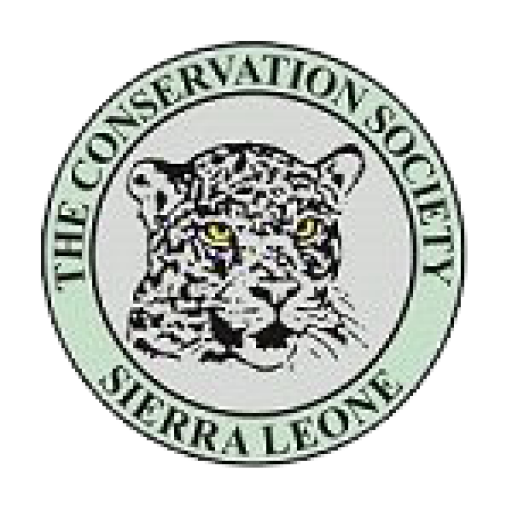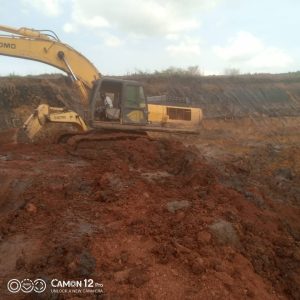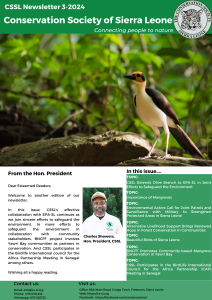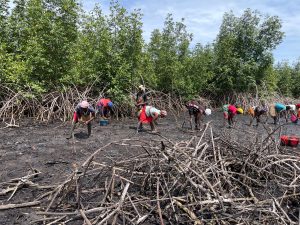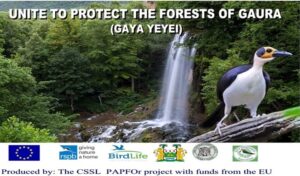 Located in Kenema district, Sierra Leone’s eastern province, the Gaura chiefdom covers an area of 398.0 square kilometres. A significant ecosystem of the chiefdom is Gayayeyei, a mountainous and hilly land mass of 828 hectares of primary forest. With an approximate population of 34,704 scattered across six towns, the lush and hilly landscape is the chiefdom’s source of clean water. Further, ecosystem is rich in biodiversity and home to chimpanzees, the black, white, and red Columbus, and the Diana Monkeys, all Endangered species listed on the International Union for Conservation of Nature (IUCN) Red List. Communities in Gaura depend on this lush ecosystem for livelihoods, which is increasingly threatened by deforestation activities including logging, upland farming, felling of trees for charcoal production, poaching, and hunting.
Located in Kenema district, Sierra Leone’s eastern province, the Gaura chiefdom covers an area of 398.0 square kilometres. A significant ecosystem of the chiefdom is Gayayeyei, a mountainous and hilly land mass of 828 hectares of primary forest. With an approximate population of 34,704 scattered across six towns, the lush and hilly landscape is the chiefdom’s source of clean water. Further, ecosystem is rich in biodiversity and home to chimpanzees, the black, white, and red Columbus, and the Diana Monkeys, all Endangered species listed on the International Union for Conservation of Nature (IUCN) Red List. Communities in Gaura depend on this lush ecosystem for livelihoods, which is increasingly threatened by deforestation activities including logging, upland farming, felling of trees for charcoal production, poaching, and hunting.
“Gayayeyai is a crying hill which tears serve as the main source of water for the entire Gaura chiefdom and its communities. The ecosystem provides refuge for countless threatened species listed on the IUCN Red list”, Patrick Dauda, CSSL’s Land-use Planning, Community Forestry and Co-Management Coordinator said.
Since October 2020, the people of Gaura have been working with the Conservation Society of Sierra Leone (CSSL) – under the European Union funded Gola PAPFor project, to conserve the forest and their only source of clean water.
“Gaura chiefdom is one of the most cooperative chiefdoms in the establishment and management of Community Forestry. I have been marvelled by the enthusiasm and commitment of the communities to conserve their forest. They have even gone to the extent of making an undertaking to preserve the ecosystem even after the PAPFor project lifespan elapses. This is a resounding demonstration of how partnership with communities can lead to sustainable outcomes”, Dauda added.
In 2021, CSSL and the six communities in the area signed a memorandum of understanding (MOU) for the establishment of Gayayeyei Community Forest.
In collaboration with the local chieftain authorities, CSSL has established and trained six Community Forest Management Committees (CFMC), both at the chieftaincy and township levels, including all legal community forest land-owning communities and families. CSSL has also trained the committees to monitor the designated areas.
“Guara has greatly benefited from implementing the community forestry project. Before the project, our communities depended on the forest as a source of livelihood and income. Due to the activities in the forest, I can still recall how few years before CSSL came, our only source of water from the hills was beginning to dry out, which led to an acute shortage of clean water. However, the situation was resolved in 2021 following the establishment of the community forest”, Abdul Borbor Musa, Chair of the chiefdom’s CFMC outlined achievements of the EU-PAPFor project.
Further, the chiefdom has enacted laws that stipulate penalties for violators of the community forest. The law also governs the activities of the 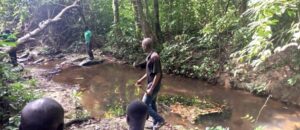 CFMC. A fine of SLE 500,000 ($ 25) is levied on anyone engaging in activities that violate the ecosystem.
CFMC. A fine of SLE 500,000 ($ 25) is levied on anyone engaging in activities that violate the ecosystem.
“We are very serious about preserving our forest. There are regular patrols of the area by members of the CFMC, who are familiar with the entire area. No one will be allowed to engage in any activity that will destroy that forest. Several persons were caught before trying to engage in these activities but were reported to the CFMC and the town. They were warned not to repeat such actions. Violators will definitely be fined”, said Lahai Nyallay an elder from Joru town, headquarters of the chiefdom.
The Gola Rainforest Company Limited by Guarantee (GRC-LG) is also supporting the initiative. GRC-LG has provided support to more than 100 farmers, who have benefited from habitat restoration through agroforestry and sustainable conservation-friendly farming. Recently, GRC-LG distributed cocoa seedlings to the farmers, as part of these activities.
“The establishment of community forest through the PAPFor project has undoubtedly increased the forest cover, thereby boosting the forest resources. Community forests have proven to be successful mechanisms in addressing the issues of forest degradation. The people of Gaura have been highly supportive of the project, and quite remarkably, they have taken up the responsibility to protect their forest”, Dauda concluded.
CSSL PAPFor has established about 31 Community Forest Management Committees or Governance Structures across 6 Chiefdoms in Gola Rainforest National Park Landscape and 1 Chiefdom in the Kambui Hills Forest Reserve Landscape.
The EU PAPFoR Programme is supported by the European Commission
Story by: Mambu James Kpargoi
Photo: Patrick Dauda/CSSL
